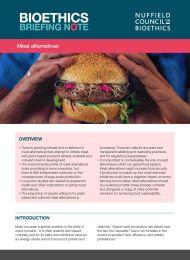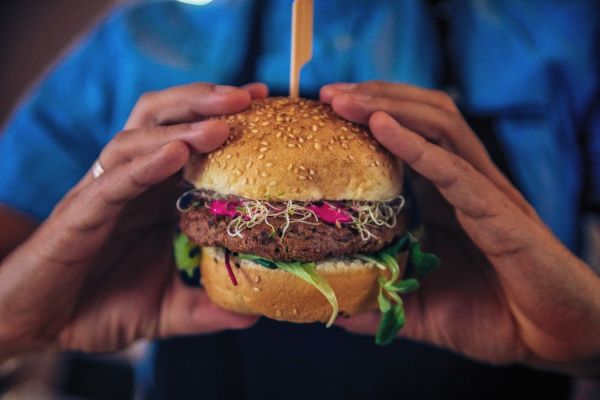Meat alternatives
Policy Briefing
Published 08/01/2020

Market trends
There has been an investment of over US$100 million in the cultured meat industry since 2015. The technology is in an early rapid development phase and faces challenges of scalability and affordability for mass markets. A prototype of a cultured beef burger, funded by Google co-founder Sergey Brin, was announced in 2013.
Cultured meat research was initially led by biomedical scientists in universities, but has more recently moved into the space of entrepreneurship. Start-ups are being funded by venture capitalists, biotech companies like Merck, and large companies in the livestock industry, including Tyson Foods and Cargill. This shift has seen an increase in intellectual property activity to secure patents. Non-profit organisations such as The Good Food Institute and New Harvest are also funding research and driving investment into cultured meat alternatives.
Methods of production
Cultured meat has been inspired by techniques used to reconstruct human muscle tissue from cells. Stem cells or cells sourced from animals are put in a growth medium and then placed on a scaffold to recreate the structure of meat. The process is housed within a closed bioreactor to provide sterility and an optimal environment for cells to be cultured. Organ printing and nanotechnology combined with tissue engineering techniques may provide further possibilities for creating cultured meat that has the characteristics of conventional meat.
Researchers in this field face several technical hurdles related to scaling up production, efficiency of the process, and recreating the texture of meat. There are concerns about the use of certain cell types such as non-human embryonic stem cells, which have unlimited regenerative potential and could accumulate genetic mutations over time.
Implications for animal welfare and the environment
Developers of cultured meat aim to eliminate the need to farm and slaughter animals for meat altogether. However, currently some animal products are still required in research, such as cells and fetal bovine serum. The latter is not viable for commercial production. Researchers are developing an artificial growth medium that would eliminate the need for fetal bovine serum.
Lifecycle assessments predict that cultured meat production would use substantially less water, land, and produce less waste than conventionally produced meat. Projections of greenhouse gas emissions for cultured meat are scenario-dependent, with some estimates suggesting that it could emit 78-96% fewer greenhouse gases. Others have raised concerns that the energy requirement of the cultured meat process, according to some assessments, could have a greater and longer-term global warming potential than cattle production, unless renewable energy is used. The true environmental benefits and costs of cultured meat will only become known once it is in production.
The Good Food Institute believes that cultured meat could reduce the environmental impacts of food production to help meet sustainability goals. This is premised on the assumption that meat alternatives will lead to a ‘substitution effect’, replacing conventional meat, and not an ‘addition effect’ whereby meat alternatives increase global meat production and consumption.
Implications for health
Cultured meat has a similar composition to meat from livestock, but the closely controlled process of production may enable a greater degree of design of the taste and nutritional components. The process might eliminate risks of zoonotic infection posed by livestock farming and could remove the need for veterinary antibiotics in closed systems of production, thus reducing the impact of industrialised meat production systems on antimicrobial resistance. Currently, antibiotics are used by a number of researchers in initial cell culturing.
The potential for contamination and bacterial growth at different stages of the culturing process might carry health risks, as might the addition of growth factors and additives, such as hormones, which are used in some conventional meat production outside the EU.* The Food Ethics Council has highlighted the need for research to assess the health risks associated with cultured meat.
* The use of animal growth hormones and the import of animals produced with growth hormones are banned in the UK. See Defra (29 August 2012) Guidance Beef cattle and dairy cows: health regulations. Comparative data is not available to indicate whether the concentrations of these hormones and growth factors in cultured meat will be higher, lower or the same as found naturally in animal tissue.
Box 3. Regulatory challenges
Concerns have been expressed about the lack of regulatory preparedness for meat alternatives. Meat alternatives will require regulatory frameworks that ensure the safety and transparency of products. Different elements of cultured meat that might require regulation include cell sourcing, safety of ingesting novel materials, protocols for preventing and monitoring contamination, requirements for managing waste, and certifying and inspecting production facilities.
In the UK, meat alternatives are expected to be regulated by the Food Standards Agency under the EU Novel Foods Regulation, unless they contain genetically modified organisms or additives that mean they fall under additional regulatory regimes within the European Food Safety Authority. The implications of the UK’s exit from the European Union for regulation in this area are currently uncertain. Timely and affordable regulatory processes that facilitate an open culture for supporting innovation are being called for.
Box 4. Public opinion
Although an increasing number of people are willing to try meat alternatives, the proportion of people who would substitute conventional meat with these products is still low. Public opinion varies by location: research in China and India indicates a higher public acceptance of meat alternatives compared with the US.
Consumers of plant-based meat alternatives comprise a high percentage of meat-eaters and those from higher-income households. Although the sustainability of plant-based products can persuade people to try meat alternatives, the appearance and taste of these products are stronger determinants of regular consumption.
Framing cultured meat as integral to sustainability with wider societal benefits can influence people to try it even if they perceive few personal benefits. Yet, some people have expressed concerns about the affordability, taste, safety, and personal health risks of cultured meat. Feelings of disgust have also been reported with people perceiving cultured meat as ‘unnatural’. (See our 2015 report (un)natural: Ideas about naturalness in public and political debates about science, technology and medicine).
People’s hopes and fears about food more generally are captured in the Food Standard Agency’s report, Our Food Future. The report states that people are concerned about a loss of social connection with food and food waste, and tend to be in favour of small scale, local production. Some feel that food is a class issue with healthy food becoming an unaffordable luxury. There are concerns about large profit-driven food businesses, and people want more transparency and traceability through clear labelling. People expect the Government to protect public and global interests in healthier and more sustainable food choices.

Share